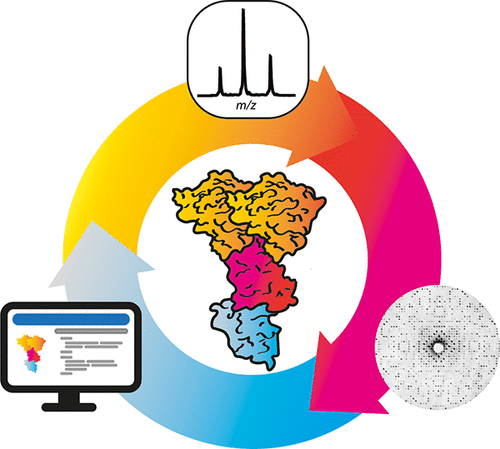当前位置:
X-MOL 学术
›
Chem. Rev.
›
论文详情
Our official English website, www.x-mol.net, welcomes your feedback! (Note: you will need to create a separate account there.)
Integration of Mass Spectrometry Data for Structural Biology
Chemical Reviews ( IF 62.1 ) Pub Date : 2021-09-10 , DOI: 10.1021/acs.chemrev.1c00356 Hannah M Britt 1 , Tristan Cragnolini 1, 2 , Konstantinos Thalassinos 1, 2
Chemical Reviews ( IF 62.1 ) Pub Date : 2021-09-10 , DOI: 10.1021/acs.chemrev.1c00356 Hannah M Britt 1 , Tristan Cragnolini 1, 2 , Konstantinos Thalassinos 1, 2
Affiliation

|
Mass spectrometry (MS) is increasingly being used to probe the structure and dynamics of proteins and the complexes they form with other macromolecules. There are now several specialized MS methods, each with unique sample preparation, data acquisition, and data processing protocols. Collectively, these methods are referred to as structural MS and include cross-linking, hydrogen–deuterium exchange, hydroxyl radical footprinting, native, ion mobility, and top-down MS. Each of these provides a unique type of structural information, ranging from composition and stoichiometry through to residue level proximity and solvent accessibility. Structural MS has proved particularly beneficial in studying protein classes for which analysis by classic structural biology techniques proves challenging such as glycosylated or intrinsically disordered proteins. To capture the structural details for a particular system, especially larger multiprotein complexes, more than one structural MS method with other structural and biophysical techniques is often required. Key to integrating these diverse data are computational strategies and software solutions to facilitate this process. We provide a background to the structural MS methods and briefly summarize other structural methods and how these are combined with MS. We then describe current state of the art approaches for the integration of structural MS data for structural biology. We quantify how often these methods are used together and provide examples where such combinations have been fruitful. To illustrate the power of integrative approaches, we discuss progress in solving the structures of the proteasome and the nuclear pore complex. We also discuss how information from structural MS, particularly pertaining to protein dynamics, is not currently utilized in integrative workflows and how such information can provide a more accurate picture of the systems studied. We conclude by discussing new developments in the MS and computational fields that will further enable in-cell structural studies.
中文翻译:

结构生物学质谱数据的整合
质谱 (MS) 越来越多地用于探测蛋白质的结构和动力学以及它们与其他大分子形成的复合物。现在有几种专门的 MS 方法,每种方法都有独特的样品制备、数据采集和数据处理协议。这些方法统称为结构 MS,包括交联、氢-氘交换、羟基自由基足迹、天然、离子淌度和自上而下的 MS。这些中的每一个都提供了一种独特类型的结构信息,从组成和化学计量到残留水平接近和溶剂可及性。结构 MS 已被证明在研究蛋白质类别方面特别有益,经典结构生物学技术的分析证明具有挑战性,例如糖基化或本质上无序的蛋白质。为了捕获特定系统的结构细节,尤其是较大的多蛋白复合物,通常需要一种以上的结构 MS 方法以及其他结构和生物物理技术。整合这些不同数据的关键是促进这一过程的计算策略和软件解决方案。我们提供了结构 MS 方法的背景,并简要总结了其他结构方法以及它们如何与 MS 相结合。然后,我们描述了用于结构生物学的结构 MS 数据整合的当前最先进的方法。我们量化了这些方法一起使用的频率,并提供了这些组合取得成果的例子。为了说明综合方法的力量,我们讨论了解决蛋白酶体和核孔复合物结构的进展。我们还讨论了来自结构 MS 的信息,特别是与蛋白质动力学有关的信息,目前如何未被用于综合工作流程,以及这些信息如何提供更准确的所研究系统的图像。最后,我们讨论了 MS 和计算领域的新发展,这将进一步实现细胞内结构研究。
更新日期:2021-09-10
中文翻译:

结构生物学质谱数据的整合
质谱 (MS) 越来越多地用于探测蛋白质的结构和动力学以及它们与其他大分子形成的复合物。现在有几种专门的 MS 方法,每种方法都有独特的样品制备、数据采集和数据处理协议。这些方法统称为结构 MS,包括交联、氢-氘交换、羟基自由基足迹、天然、离子淌度和自上而下的 MS。这些中的每一个都提供了一种独特类型的结构信息,从组成和化学计量到残留水平接近和溶剂可及性。结构 MS 已被证明在研究蛋白质类别方面特别有益,经典结构生物学技术的分析证明具有挑战性,例如糖基化或本质上无序的蛋白质。为了捕获特定系统的结构细节,尤其是较大的多蛋白复合物,通常需要一种以上的结构 MS 方法以及其他结构和生物物理技术。整合这些不同数据的关键是促进这一过程的计算策略和软件解决方案。我们提供了结构 MS 方法的背景,并简要总结了其他结构方法以及它们如何与 MS 相结合。然后,我们描述了用于结构生物学的结构 MS 数据整合的当前最先进的方法。我们量化了这些方法一起使用的频率,并提供了这些组合取得成果的例子。为了说明综合方法的力量,我们讨论了解决蛋白酶体和核孔复合物结构的进展。我们还讨论了来自结构 MS 的信息,特别是与蛋白质动力学有关的信息,目前如何未被用于综合工作流程,以及这些信息如何提供更准确的所研究系统的图像。最后,我们讨论了 MS 和计算领域的新发展,这将进一步实现细胞内结构研究。


























 京公网安备 11010802027423号
京公网安备 11010802027423号